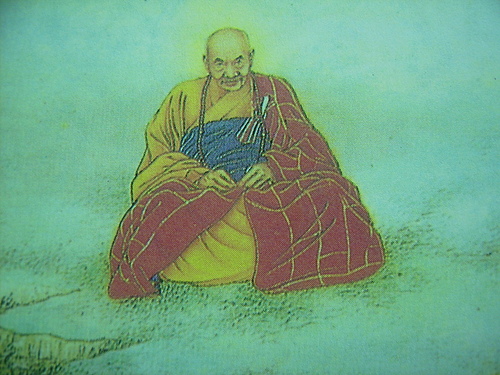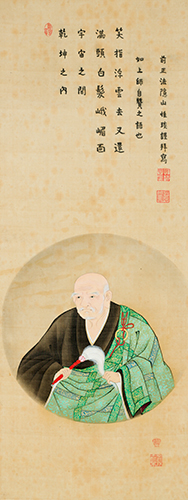ZEN MESTEREK ZEN MASTERS
« Zen főoldal
« vissza a Terebess Online nyitólapjára

峨山慈棹 Gasan Jitō (1727-1797)
Gasan Jitô
(1727–1797) Japanese Rinzai monk who
trained under Hakuin Ekaku
(1685–1768) and is generally counted
among his Dharma heirs. Gasan was
born in northeastern Japan in Oshû. He
originally practiced Zen under the
Rinzai master Gessen Zen’e (1702–1781);
he came to Hakuin much later
in his career. It is unclear whether
Gasan actually received inka from
Hakuin before the master died.
Nevertheless, Gasan’s disciples consti-
tute the most important lineage of
Hakuin Zen. Along with his disciples,
Inzan Ien (1751–1814) and Takujû Kosen
(1760–1833), Gasan continued
the reforms of the Rinzai system of
kôan study that were initiated by
Hakuin. Gasan is said to have taught
some 500 disciples at Rinshô-in in Edo
and did much to promote Hakuin Zen.
https://pl.wikipedia.org/wiki/Gasan_Jit%C5%8D
Gasan's Dharma Lineage
[...]
菩提達磨 Bodhidharma, Putidamo (Bodaidaruma ?-532/5)
大祖慧可 Dazu Huike (Taiso Eka 487-593)
鑑智僧璨 Jianzhi Sengcan (Kanchi Sōsan ?-606)
大毉道信 Dayi Daoxin (Daii Dōshin 580-651)
大滿弘忍 Daman Hongren (Daiman Kōnin 601-674)
大鑑慧能 Dajian Huineng (Daikan Enō 638-713)
南嶽懷讓 Nanyue Huairang (Nangaku Ejō 677-744)
馬祖道一 Mazu Daoyi (Baso Dōitsu 709-788)
百丈懷海 Baizhang Huaihai (Hyakujō Ekai 750-814)
黃蘗希運 Huangbo Xiyun (Ōbaku Kiun ?-850)
臨濟義玄 Linji Yixuan (Rinzai Gigen ?-866)
興化存獎 Xinghua Cunjiang (Kōke Zonshō 830-888)
南院慧顒 Nanyuan Huiyong (Nan'in Egyō ?-952)
風穴延沼 Fengxue Yanzhao (Fuketsu Enshō 896-973)
首山省念 Shoushan Shengnian (Shuzan Shōnen 926-993)
汾陽善昭 Fenyang Shanzhao (Fun'yo Zenshō 947-1024)
石霜/慈明 楚圓 Shishuang/Ciming Chuyuan (Sekisō/Jimei Soen 986-1039)
楊岐方會 Yangqi Fanghui (Yōgi Hōe 992-1049)
白雲守端 Baiyun Shouduan (Hakuun Shutan 1025-1072)
五祖法演 Wuzu Fayan (Goso Hōen 1024-1104)
圜悟克勤 Yuanwu Keqin (Engo Kokugon 1063-1135)
虎丘紹隆 Huqiu Shaolong (Kukyū Jōryū 1077-1136)
應庵曇華 Yingan Tanhua (Ōan Donge 1103-1163)
密庵咸傑 Mian Xianjie (Mittan Kanketsu 1118-1186)
松源崇岳 Songyuan Chongyue (Shōgen Sūgaku 1132-1202)
運庵普巖 Yunan Puyan (Un'an Fugan 1156–1226)
虛堂智愚 Xutang Zhiyu (Kidō Chigu 1185–1269)
南浦紹明 Nampo Jōmyō (1235-1308) [大應國師 Daiō Kokushi]
宗峰妙超 Shūhō Myōchō (1282-1337) [大燈國師 Daitō Kokushi
關山慧玄 Kanzan Egen (1277-1360) [無相大師 Musō Daishi]
授翁宗弼 Juō Sōhitsu (1296-1380)
無因宗因 Muin Sōin (1326-1410)
日峰宗舜 Nippō Shōshun (1367-1448)
義天玄詔 Giten Genshō
雪江宗深 Sekkō Sōshin (1408–1486)
東陽英朝 Tōyō Eichō (1428-1504) > 禪林句集 Zenrin-kushū
大雅耑匡 Taiga Tankyō (?–1518)
功甫玄勳 Kōho Genkun (?–1524)
先照瑞初 Senshō Zuisho
以安智泰 Ian Chisatsu (1514–1587)
東漸宗震 Tōzen Sōshin (1532–1602)
庸山景庸 Yōzan Keiyō (1559–1629)
愚堂東寔 Gudō Tōshoku (1577–1661)
至道無難 Shidō Bunan (1603–1676)
道鏡慧端 Dōkyō Etan (1642-1721) [aka 正受老人 Shōju Rōjin]
白隱慧鶴 Hakuin Ekaku (1686-1769)
峨山慈棹 Gasan Jitō (1727-1797)

GASAN JITO
Richard Bryan McDaniel: Zen Masters of Japan. The Second Step East. Rutland, Vermont: Tuttle Publishing, 2013.
Gasan Jito was one of Hakuin’s later students who completed his training under Torei Enji’s tutelage.
He had begun his studies with Gessen Zenne, who was a Dharma successor of Kogetsu Zenzai. The records of the Hakuin School portray Gessen as a rival of Hakuin, perhaps jealous of the more famous teacher’s popularity. Several of Gessen’s students, like Gasan, would go on to work with Hakuin. However, Gessen was an accomplished Zen master whose Dharma heirs included Sengai Gibon.
Gasan achieved an initial kensho while with Gessen, then undertook the traditional pilgrimage to other temples. None of the masters he visited, however, had anything more to teach him, and he returned to Gasan, convinced that he was now fully awakened. Gasan concurred and told Gessen that he had no further need to test his understanding.
Gasan remained with his teacher for a while longer before it occurred to him that the one Zen Master he had not yet visited was Hakuin Ekaku. He mentioned the matter to Gessen, but Gessen assured him there was no need to visit Hakuin. So Gasan did not pursue the matter any further. About a year later, however, Hakuin was giving a series of lectures in Edo, and Gasan attended one out of curiosity. He was so impressed with what he heard that he took formal leave of Gessen and traveled to Hara in order to study with Hakuin.
During their first interview, Gasan intended to present Hakuin with his understanding of the Dharma, but, after only a few words, Hakuin laughed derisively and demanded, “What charlatan has deluded you so much that you feel qualified to come here and foul the air with your breath?” Then he thrust Gasan from the room.
Twice more Gasan sought admission to Hakuin’s community of monks, and twice more the old man sent him away.
Through all of this, Gasan had maintained his belief that what he had achieved under Gessen’s guidance had been genuine and complete awakening. He supposed that Hakuin was only refusing to acknowledge the fact as some form of test. After being dismissed the third time, however, he reflected that a teacher of Hakuin’s reputation would not behave as he was without good cause.
On the next occasion he met with Hakuin, Gasan began by apologizing for presuming to present himself as an awakened individual and humbly asked for Hakuin’s instruction.
“What you have is genuine enough,” Hakuin told him, “but it is still only a tongue-tip taste of Zen. You still need to hear the sound of one hand clapping.”
For the next four years, Gasan applied himself to zazen under Hakuin’s direction, continuing it under Torei Enji after Hakuin died. It was from Torei that Gasan finally received inka.
Gasan became one of the foremost proponents of what was then being called “Hakuin Zen,” and he served for a time as abbot of Shoinji. His two most important heirs were Inzan Ien and Takuju Kosen.